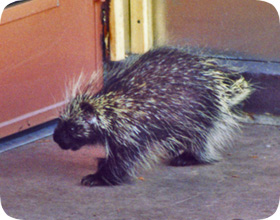-
info@aaanimalcontrol.com
Call us for help in your town
Humane Wildlife Education
Humane Ways to Trap a Porcupine
Need porcupine removal in your hometown? We service over 500 USA locations! Click here to hire us in your town and check prices - updated for year 2020.
Porcupines are unique animals that can be found in many parts of the United States, and although they are not the fastest of animals they do have a unique defense mechanism that makes trapping them quite challenging. These animals are not particularly aggressive and will look to avoid confrontation if possible, but their quills are the problem. These quills cannot be projected at predators as many rumors suggest, but they can be released on contact, and once they are embedded in flesh their sharp barbs will painfully tear the flesh as they are being removed.

The Best Trap For A Porcupine
The most common trap that will be used to catch a porcupine is the cage trap, and because they are generally solitary animals then a single catch trap will often be suitable to catch the porcupine. It is also possible to use a leg hold trap to catch a porcupine alive, but because of the problems associated with handling a porcupine a cage trap is usually the most popular option.
The name for porcupines comes from the fact that they were often used as an animal that was trapped for meat, with the ‘porc’ part of the name coming from the fact that it is said to be similar in flavor to pork. Traditional snares are still used to catch porcupines today by many people, but with very few people actually wanting to eat or use any part of a porcupine, live trapping is by far the most prevalent option.
Choosing The Best Position For A Porcupine Trap
Porcupines are animals that can become a pest because of their habit of chewing and eating the bark around the base of a tree, and it is this habit that will decide the best location for a trap. By placing the trap near the base of a tree that has already been used for food by a porcupine, then the animal will often return to the same place where it has already found a good source of food.
Bait To Catch A Porcupine
Porcupine traps do not necessarily have to have specific bait, because they will work more because of the location than because of the bait. One of the major problems for porcupines in the wild will be finding a good source of salt, so some people will often use a piece of bark or leather that has been soaked in a salt solution as the bait for the trap. The salt can also be combined with vegetable oil or pieces of carrot or turnip to make suitable bait.
The Vital Precautions When Handling A Porcupine
The biggest threat of a porcupine is the quills which are such an effective deterrent to predators, and these are the reason why people would be wise to avoid any contact at all with the porcupine if at all possible. Thick canvas glove and protective clothing are the minimum requirements, and using a snare pole or the cage trap for transport will also be a welcome precaution. It is vital that you keep the porcupine away from any dogs, as they will often be too inquisitive and can suffer significant harm from coming into contact with the porcupine.
Relocating A Porcupine
Porcupines are not particularly quick or aggressive, so they can be relocated quite easily for those who are using a cage trap. Those that have caught the porcupine in another type of trap should place it in a sealed box with holes for air, or into a travel cage so that the animal can be transported. Release the animal at least ten miles away from your property to into an area of natural wildlife away from any agricultural land, and they will usually leave the cage quite happily.
Read more on my main how to get rid of porcupines page or my how to keep away porcupines page.


















